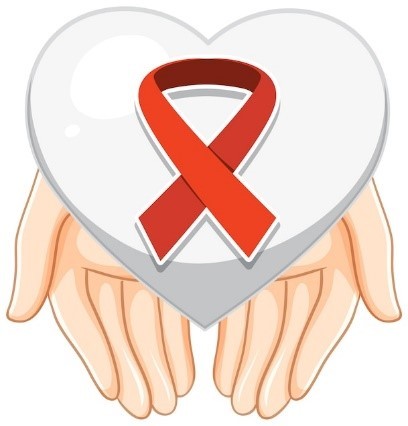
Обычная версия сайта
Republic of Kazakhstan, Almaty, Raimbek Ave., 60
Location map+7 (727) 39742 23 Reception
+7 (727) 39742 17 Registry
+7 (727) 39742 06 Helpline
1414 Single contact center


Обычная версия сайта
Republic of Kazakhstan, Almaty, Raimbek Ave., 60
Location map+7 (727) 39742 23 Reception
+7 (727) 39742 17 Registry
+7 (727) 39742 06 Helpline
1414 Single contact center

December 1, 2023
World AIDS Day is one of the important international events aimed at drawing attention to the issues of HIV prevention around the world.
World AIDS Day has been held annually on December 1 since 1988, and since 1996, the organization of this day has been under the leadership of UNAIDS, the UN program aimed at combating HIV and AIDS.
The purpose of this day is to raise awareness of the world's population about HIV infection, modes of transmission and prevention of this disease.
HIV infection is caused by the “human immunodeficiency virus” and is primary. The abbreviation “AIDS” stands for “acquired immune deficiency syndrome”, and it is the final stage of HIV infection. HIV infection attacks the human immune cells that protect the body, suppresses them and destroys them, leading to AIDS. The lack of a person’s immune defense leads to the occurrence of diseases that he would never get if he were healthy.
The history of the discovery of HIV infection is closely connected with its stigmatization in society, the desire to “silence” the problem, and the long absence of adequate treatment. It is still not known for certain where HIV came from. The scientific community believes that HIV originated in the early 20th century, probably in the 1920s. Scientists have found that the virus originated in West and Central Africa (sub-Saharan Africa) and was transmitted from monkeys to humans.
The disease itself was not immediately identified. In 1981, three scientific articles appeared about diseases that developed in an unusual way. The diseases themselves were familiar to the scientific community, but those who “should” were not suffering from them. At that time, these cases were not connected into a single chain, but by July 1982 the term AIDS was proposed, and by September of the same year the disease was defined and characterized.
According to UNAIDS statistics in 2022 in the world:
The main reason for the spread of HIV infection among the population is unprotected sex. The disease can also be transmitted through contact of damaged skin of a healthy person with some biological fluids of a sick person (only seminal fluid and vaginal secretions contain HIV in sufficient quantities for infection), through mucous membranes. Infection can occur through syringes and needles (if they were used more than once), through blood. HIV can be transmitted from mother to child during pregnancy, childbirth, or the postpartum period. The virus is not transmitted by airborne droplets; it cannot be contracted through household contact, through insect bites or through saliva. The virus dies in the external environment under the influence of sunlight, high temperatures, and upon contact with acidic, alkaline and salty environments.
The disease poses the greatest danger in countries where there is no high level of healthcare. But no less dangerous is the lack of knowledge about the disease and the confidence that “it certainly won’t affect me.”
Unprotected sex is the most common way of transmitting the infection, as with many other sexually transmitted infections, so it is important to use condoms every time you have risky sex.
Despite the fact that the disease is still not completely cured, there are now medications that can suppress HIV and put patients into remission.
This year's theme for World AIDS Day is LEADERSHIP TO COMMUNITIES: “The world can end AIDS when communities lead the fight.” And, indeed, the effectiveness of almost all prevention programs directly depends on the active participation in their implementation of community representatives, outreach workers from communities and key population groups. Organizations from communities living with, affected by, or at risk of HIV are on the front lines of the response to the epidemic.
In Kazakhstan, from November 20 to December 1, 2023, within the framework of the ten-day period of World AIDS Day, the Kazakh Scientific Center of Dermatology and Infectious Diseases, the National Center for Public Health, regional and city public health departments, HIV prevention centers together with non-governmental organizations, youth Health centers and other departments in all regions will organize activities to prevent HIV infection. In educational institutions, business structures, military units, penitentiary institutions, shopping and entertainment centers and other places of public presence, specialists and community leaders will inform about ways to prevent HIV infection, the inadmissibility of stigma and discrimination towards people living with HIV, will provide the opportunity to undergo rapid testing.
Communities are leading World AIDS Day around the world, organizing events and making compelling calls to meet their urgent needs. “Ending AIDS is possible and it is in our hands,” says UNAIDS Executive Director Winnie Byanyima. “To get on the path to ending AIDS, the world must let communities lead the way. Lack of funding, political and regulatory restrictions, reduced activity due to resource constraints, and erosion of civil and human rights in marginalized communities all impede the successful delivery and receipt of HIV prevention and treatment services. If these barriers are removed, community organizations can provide even greater momentum to the global HIV response, contributing to the end of AIDS.
Today, World AIDS Day remains relevant, reminding people and governments that HIV is far from over. It remains critical to attract additional financial resources to the AIDS response to raise awareness of the impact of HIV on people's lives, eradicate stigma and discrimination, and improve the quality of life of people living with HIV.
Links: https://www.unaids.org/ru/2023-world-aids-day https://www.unaids.org/ru/World_AIDS_Day
https://www.unaids.org/ru/resources/fact-sheet
Kulzhanova D.R.


